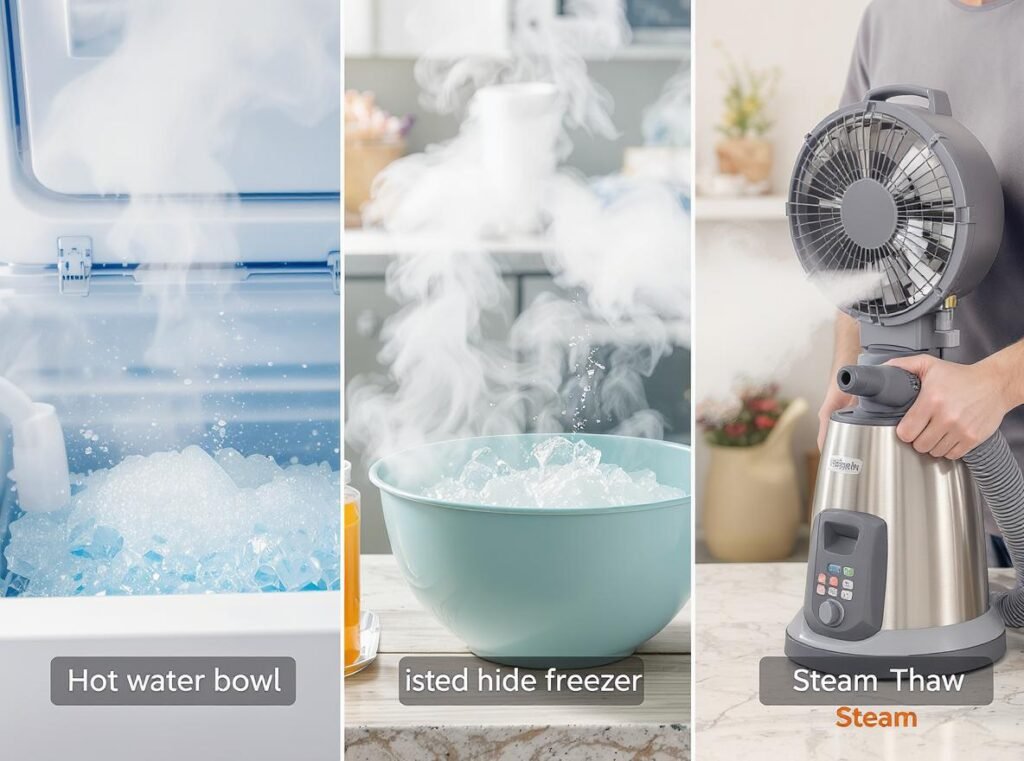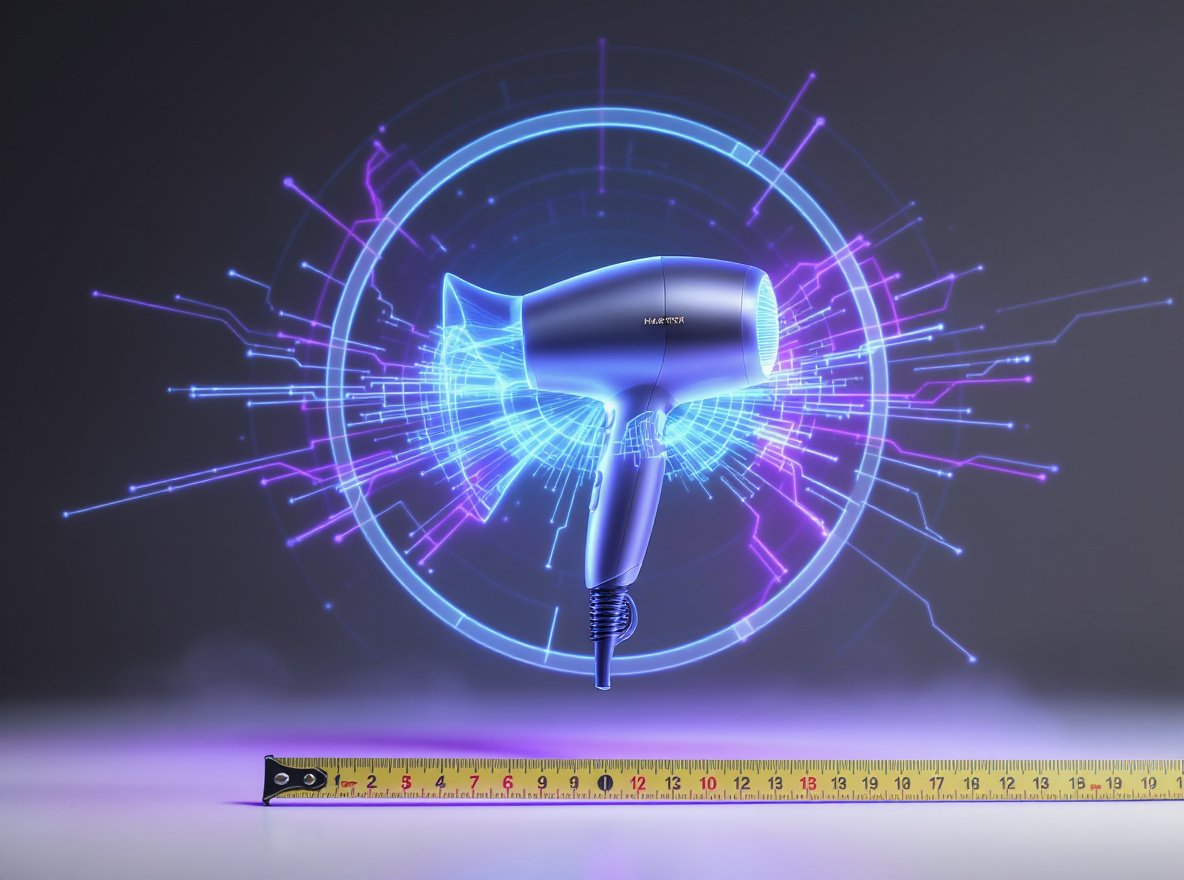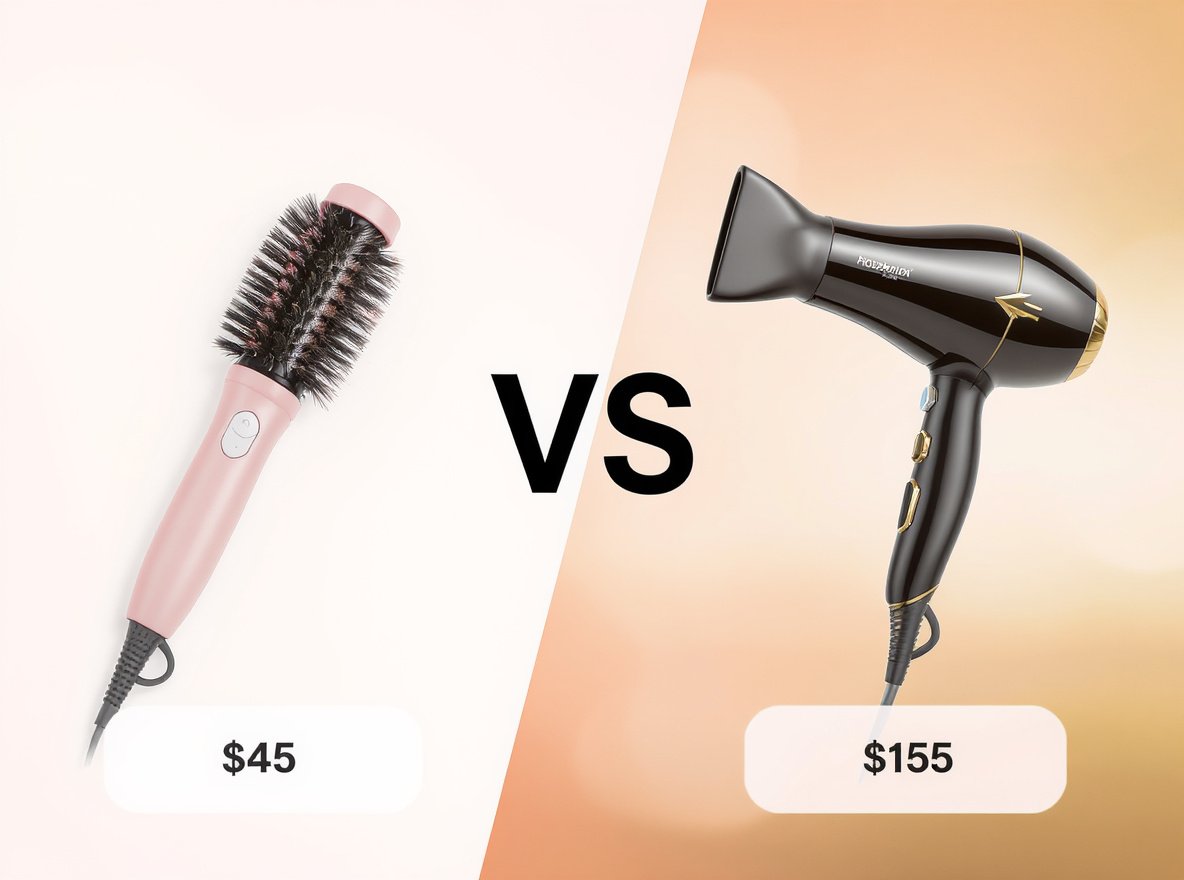Ice buildup in your freezer is costing you money and making your appliance work harder. You’re looking for a quick solution and wondering if that hair dryer sitting in your bathroom drawer could speed up the defrosting process.
Yes, hair dryers can help defrost a freezer by directing warm air onto ice buildup, causing it to melt more quickly than natural thawing. However, this method requires extreme caution due to electrical hazards from water exposure and potential overheating damage to plastic freezer components. The process typically takes 30 minutes to several hours depending on ice thickness, making it slower than many safer alternatives.
Let’s explore everything you need to know about using hair dryers for freezer defrosting, including safer alternatives that might work better for your situation.
Table of Contents
ToggleIs It Safe to Use a Hair Dryer to Defrost a Freezer?
Many people consider using hair dryers for quick defrosting, especially when facing thick ice buildup that could take hours to melt naturally.
Using a hair dryer to defrost a freezer can be safe if done carefully, but significant risks remain. The primary dangers include electric shock from water dripping into the dryer, overheating damage to plastic components, and fire risks from prolonged use in confined spaces. Never leave the hair dryer unattended, and always ensure proper electrical precautions.

The primary safety concerns include:
Water and electricity create a dangerous combination. When ice melts, it produces water that can come into contact with electrical components. Even small amounts of moisture can cause short circuits or electrocution.
Heat damage represents another significant risk. Freezer interiors contain plastic components, insulation materials, and delicate cooling coils that weren’t designed to withstand concentrated heat from hair dryers. Excessive heat can warp walls, damage seals, or even puncture refrigerant lines.
Warranty implications matter for newer appliances. Most manufacturers explicitly advise against using heat sources like hair dryers for defrosting, and doing so may void your warranty coverage.
| Risk Factor | Severity | Prevention Method |
|---|---|---|
| Electrocution | High | Keep dryer away from water, use GFCI outlet |
| Heat Damage | Medium | Use low heat, maintain distance from surfaces |
| Warranty Void | Low-Medium | Check manual before proceeding |
What’s the Safest Way to Use a Hair Dryer for Defrosting?
If you decide to proceed with hair dryer defrosting despite the risks, following strict safety protocols becomes essential.
When using a hair dryer for defrosting, always unplug the freezer first, place towels to absorb meltwater, use the lowest heat setting, keep the dryer moving constantly, and maintain safe distance from ice. Never use metal tools to chip ice, as this can puncture freezer walls or damage cooling coils. Always supervise the entire process.

Essential safety steps include:
Preparation prevents accidents. Remove all food items and store them in coolers or another freezer. Unplug the freezer completely to eliminate any electrical conflicts. Place absorbent towels around the base and have extras ready.
Equipment positioning requires careful attention. Use a GFCI-protected outlet located away from the freezer area. Keep extension cords elevated and away from potential water contact. Position yourself so you can quickly move away if water begins pooling.
Technique matters significantly. Use only cool or low heat settings to minimize heat damage risk. Maintain at least 6 inches distance between the dryer and freezer surfaces. Work systematically from top to bottom, allowing gravity to help with ice removal.
- Start with thick ice areas where the dryer can be most effective
- Move the dryer constantly to prevent concentrated heating
- Stop immediately if you notice any warping or unusual sounds
- Have someone nearby who can shut off power if needed
How Long Does Hair Dryer Defrosting Take?
Time requirements vary significantly based on ice thickness, freezer size, and hair dryer power output.
Hair dryer defrosting typically takes anywhere from 30 minutes to several hours, depending on ice thickness and freezer size. Many users report that it “takes ages” compared to other methods. The process is generally slower and less efficient than alternatives like hot water bowls, which conduct heat more effectively.

Factors affecting defrosting time:
Ice thickness determines the primary time requirement. Quarter-inch ice buildup responds quickly to directed heat, while thick accumulations of half an inch or more require patience and multiple passes.
Hair dryer specifications significantly impact effectiveness. Higher wattage units (1800+ watts) work faster than basic models, but also generate more heat and require extra caution. Professional salon dryers often provide better control options.
Freezer characteristics influence the process. Chest freezers with top-opening doors allow easier access and gravity-assisted ice removal. Upright freezers with side doors present more challenges for drainage and positioning.
Working methodically prevents safety issues. Taking breaks every 10-15 minutes prevents dryer overheating and allows you to assess progress safely. Rushing the process increases accident risk significantly.
What Are Better Alternatives to Hair Dryer Defrosting?
Several methods offer safer and often more effective defrosting than hair dryers.
The most effective defrosting alternatives include hot water bowls (fastest and safest), natural thawing (slowest but completely safe), fan circulation (moderate speed with high safety), and steam cleaners (fast but requiring proper handling). Hot water bowls conduct heat more efficiently than hair dryers and eliminate electrical hazards entirely.

Professional-recommended alternatives:
Hot water bowl method provides the fastest and safest results. Place bowls or pans of hot (not boiling) water inside the freezer and close the door. The contained steam conducts heat more efficiently than direct air from hair dryers and eliminates all electrical hazards. Replace water every 15-20 minutes for consistent results.
Natural thawing offers complete safety but requires patience. Simply unplug the freezer, open the door, and allow ice to melt naturally. This method can take several hours to a full day depending on ice thickness, but carries zero risk of electrical accidents or heat damage.
Steam cleaner technique provides professional results. For those with access to steam cleaning equipment, this method quickly melts ice and proves effective for stubborn buildup. However, proper handling remains essential to avoid burns or water damage.
| Method | Speed | Safety Level | Effectiveness | Notes |
|---|---|---|---|---|
| Hot Water Bowls | Fast | Very High | High | Conducts heat efficiently, no electrical risk |
| Natural Thaw | Very Slow | Very High | High | No risk, but takes longest (up to 24 hours) |
| Fan Circulation | Moderate | High | Moderate | Speeds up natural thaw safely |
| Hair Dryer | Moderate | Low-Moderate | Moderate | Risk of electric shock, takes ages |
| Steam Cleaner | Fast | Moderate | High | Effective but requires proper handling |
When Should You Defrost Your Freezer?
Regular defrosting prevents excessive ice buildup and maintains freezer efficiency.
Defrost your freezer when ice buildup exceeds ¼ inch (about 6mm) thick, or at least once annually. Excessive frost reduces efficiency and storage space significantly. Regular defrosting prevents major ice accumulations that require more time and effort to remove.

Timing considerations affect the defrosting process:
Seasonal planning makes defrosting easier. Winter months often provide natural assistance when you can store frozen items outside temporarily. Avoid defrosting during hot summer months when food safety becomes more challenging.
Ice thickness monitoring prevents major buildups. Check monthly for ice accumulation, especially around door seals and evaporator coils. Early intervention requires less time and creates fewer safety hazards.
Energy cost implications justify regular maintenance. Even 1/4 inch of ice buildup can increase energy consumption by 10-15%. Regular defrosting maintains efficiency and reduces utility bills significantly.
Food safety requires proper planning. Defrosting takes time, so plan when you have minimal frozen food inventory. Use coolers with ice packs or coordinate with neighbors who have freezer space available.
Can Professional Hair Dryers Make Defrosting Safer?
Professional-grade hair dryers offer features that potentially improve defrosting safety and effectiveness.
Professional hair dryers may offer features like lower heat settings, better temperature control, and enhanced safety features compared to consumer models. However, the fundamental risks of electric shock, water exposure, and overheating remain the same. Professional models may be more durable, but they do not eliminate the basic hazards associated with using electrical appliances near water.

Professional advantages include:
Temperature precision allows better heat control. Professional models often feature specific temperature settings rather than just high/medium/low options. This precision helps prevent overheating of freezer components while maintaining effective ice melting.
Airflow volume affects efficiency significantly. Professional dryers typically generate higher cubic feet per minute (CFM) of airflow, which can remove moisture more effectively and reduce the time spent with electrical equipment near water.
Build quality impacts safety features. Professional models often include better overheating protection, more durable cords, and improved motor ventilation. These features reduce equipment failure risks during extended defrosting sessions.
For businesses in the hair dryer industry, understanding these applications helps demonstrate product versatility. The Conason P1C professional hair dryer, designed for salon use, incorporates advanced safety features and precise temperature controls that make it more suitable for specialized applications than consumer models.
- Ionic technology reduces static and improves airflow efficiency
- Multiple heat and speed combinations provide optimal control
- Professional-grade components ensure consistent performance
- Advanced overheating protection systems prevent equipment damage
What Should Wholesalers Know About Hair Dryer Defrosting Applications?
Understanding alternative uses helps hair dryer wholesalers better serve diverse customer needs.
Hair dryer wholesalers should understand that while customers sometimes use hair dryers for defrosting, this is not their intended purpose. When marketing hair dryers, emphasize their primary function for hair styling and caution against non-standard applications that may void warranties or pose safety risks. For commercial defrosting needs, recommend specialized equipment designed for safe use around water and refrigeration units.

Market considerations for wholesalers:
Customer education creates value-added service. Providing safety guidelines and proper techniques demonstrates expertise and builds customer trust. Retailers appreciate suppliers who help them answer customer questions about product applications.
Product differentiation becomes clearer when explaining advanced features. Professional models with precise temperature controls, ionic technology, and safety features command higher prices when customers understand their superior capabilities for various applications.
Safety liability requires clear communication. Wholesale customers need proper documentation about recommended uses and safety warnings. Clear guidelines protect both wholesalers and retailers from liability issues.
Business applications extend beyond personal use. Hotels, restaurants, and commercial facilities sometimes need emergency defrosting solutions. Professional-grade hair dryers serve these markets better than consumer models.
The hair dryer industry continues evolving with new technologies and safety features. Wholesalers who understand diverse applications can better serve customers and identify opportunities for premium product positioning.
| Customer Type | Preferred Features | Key Selling Points |
|---|---|---|
| Professional Salons | Precise controls, durability | Performance and reliability |
| Commercial Users | Safety features, power | Versatility and efficiency |
| Retail Consumers | Ease of use, price | Value and basic functionality |
Summary
Hair dryers can defrost freezers but often take longer than safer alternatives and carry significant electrical risks. Hot water bowls provide faster, safer results by conducting heat more efficiently. Professional hair dryers offer better features but don’t eliminate fundamental safety hazards. Wholesalers should emphasize proper hair styling applications rather than promoting non-standard uses that may void warranties.
Ready to explore professional-grade hair dryers with advanced safety features? Browse our complete collection of high-performance hair dryers at Conason Products or learn more about our flagship P1C Professional Hair Dryer designed for demanding applications. Contact our wholesale team today to discuss how advanced hair dryer technology can serve your customers’ diverse needs.



